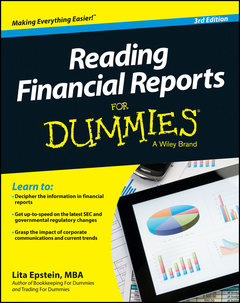Description
Reading Financial Reports For Dummies (3rd Ed.)
Author: Epstein Lita
Language: English
Subject for Reading Financial Reports For Dummies:
Approximative price 24.02 €
In Print (Delivery period: 12 days).
Add to cart
Publication date: 02-2014
384 p. · 18.9x23.4 cm · Paperback
384 p. · 18.9x23.4 cm · Paperback
Description
/li>Contents
/li>
Discover how to decipher financial reports Especially relevant in today′s world of corporate scandals and new accounting laws, the numbers in a financial report contain vitally important information about where a company has been and where it is going. Packed with new and updated information, Reading Financial Reports For Dummies, 3rd Edition gives you a quick but clear introduction to financial reports&ndash,and how to decipher the information in them. New information on the separate accounting and financial reporting standards for private/small businesses versus public/large businesses New content to match SEC and other governmental regulatory changes New information about how the analyst–corporate connection has actually changed the playing field The impact of corporate communications and new technologies New examples that reflect current trends Updated websites and resources Reading Financial Reports For Dummies is for investors, traders, brokers, managers, and anyone else who is looking for a reliable, up–to–date guide to reading financial reports effectively.
Introduction 1 Part I: Getting Started with Reading Financial Reports 5 Chapter 1: Opening the Cornucopia of Reports 7 Chapter 2: Recognizing Business Types and Their Tax Rules 19 Chapter 3: Public or Private: How Company Structure Affects the Books 27 Chapter 4: Digging into Accounting Basics 41 Part II: Checking Out the Big Show: Annual Reports 57 Chapter 5: Exploring the Anatomy of an Annual Report 59 Chapter 6: Balancing Assets against Liabilities and Equity 73 Chapter 7: Using the Income Statement 89 Chapter 8: The Statement of Cash Flows 105 Chapter 9: Scouring the Notes to the Financial Statements 119 Chapter 10: Considering Consolidated Financial Statements 137 Part III: Analyzing the Numbers 149 Chapter 11: Testing the Profits and Market Value 151 Chapter 12: Looking at Liquidity 169 Chapter 13: Making Sure the Company Has Cash to Carry On 179 Part IV: Understanding How Companies Optimize Operations 191 Chapter 14: How Reports Help with Basic Budgeting 193 Chapter 15: Turning Up Clues in Turnover and Assets 203 Chapter 16: Examining Cash Inflow and Outflow 215 Chapter 17: How Companies Keep the Cash Flowing 225 Part V: The Many Ways Companies Answer to Others 233 Chapter 18: Finding Out How Companies Find Errors: The Auditing Process 235 Chapter 19: Digging into Government Regulations 245 Chapter 20: Creating a Global Financial Reporting Standard 257 Chapter 21: Checking Out the Analyst&ndash,Corporation Connection 267 Chapter 22: How Companies Communicate with Shareholders 279 Chapter 23: Keeping Score When Companies Play Games with Numbers 293 Part VI: The Part of Tens 315 Chapter 24: Ten (+1) Financial Scandals That Rocked the World 317 Chapter 25: Ten Signs That a Company&rsquo,s in Trouble 327 Glossary 333 Index 341
© 2024 LAVOISIER S.A.S.

